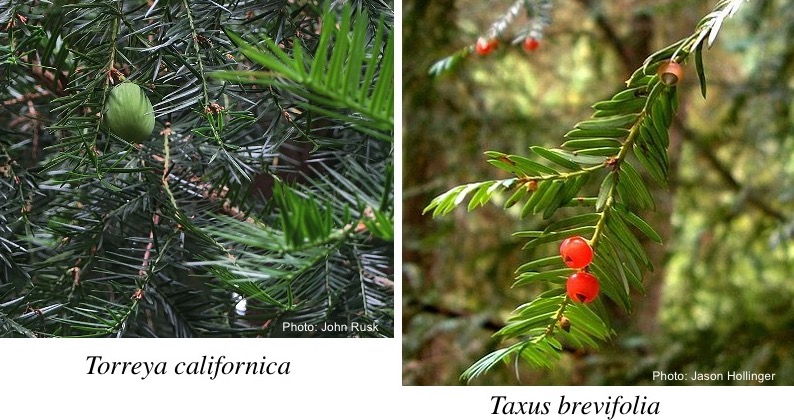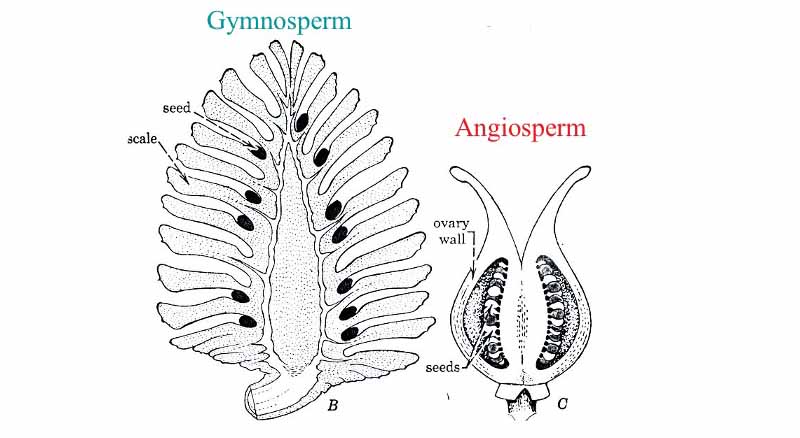
Gymnosperms
Gymnosperms ("naked seed" plants) are plants that produce seeds but do not enclose them in an ovary. The ovules/seeds are exposed to the environment.

They have
Seeds and pollen are borne in separate cones (pollen cones and seed cones).
Species may be monoecious or dioecious.
Check your understanding:
A strobilus is just a terminal collection of sporophylls (modified leaves that bear sporangia).
A simple strobilus is just that: a set of leaf-like structures (sporophylls) that bear pollen sacs or a set of leaf-like structures (sporophylls) that bear ovules.
A compound strobilus is a more branched system. The structure that bears the sporangia (the pollen sacs or ovules) appears to be a modified branch that is in the axil of modified leaf (a bract). We use the term "cone scale" for the modified branch that bears the pollen sacs or ovules. The cone scale sits in the axil of the leaf-like structure we call a "cone bract" or just "bract".
Check your understanding:
In some taxa that have compound strobili, the bract is fused to the abaxial side of the cone scale. In other taxa, the bract is free (not fused).
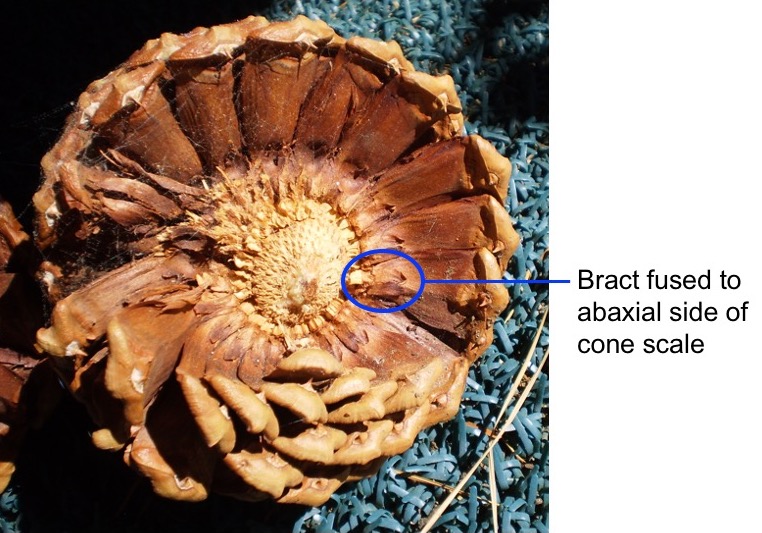
The pollen cone of a pine tree (below) is one example of a simple strobilus. It is simply an arrangement of sporophylls.
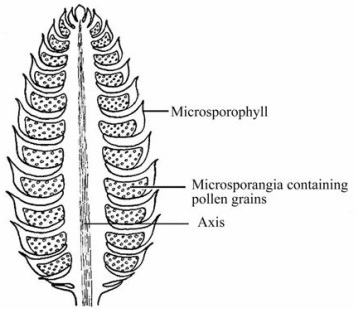
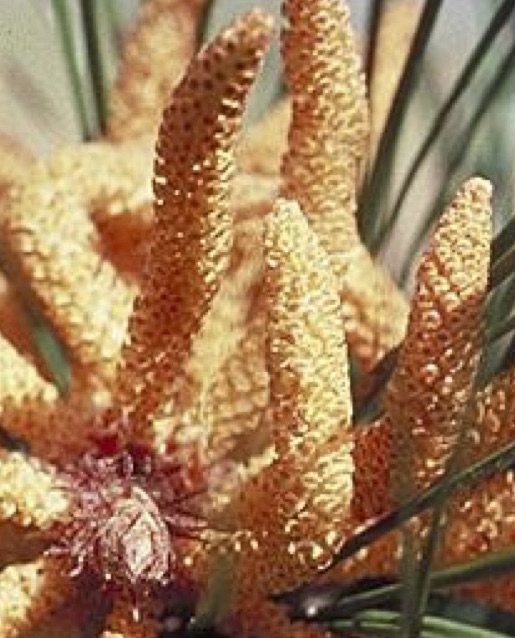
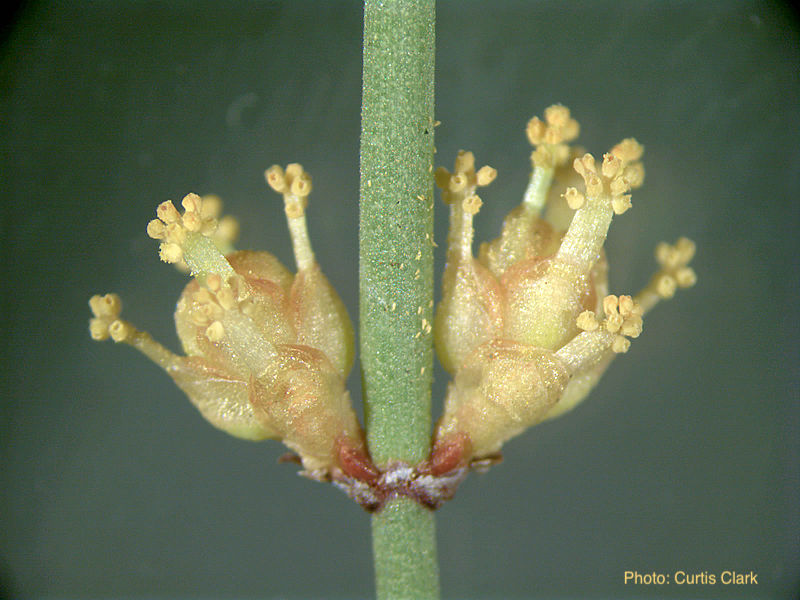 Some gymnosperms have sessile pollen sacs and others have stalked pollen sacs.
Some gymnosperms have sessile pollen sacs and others have stalked pollen sacs.
The pollen cones of pines have pollen sacs that are sessile on the abaxial side of each pollen cone scale. These cones are shown to the left and diagramed above.
Other gymnosperms have stalked pollen sacs. These bear a superficial resemblance to the stamens of angiosperms. The pollen sacs of Ephedra, shown to the right, are stalked. (You may also notice that the pollen cone of Ephedra is a compound strobilus, with bracts subtending the structure that bears the pollen sacs.
Some cone scales are peltate; others are not
Peltate scales (like peltate leaves) are shaped somewhat like a parasol, with a stalk that attaches to the lower surface rather than to the edge.
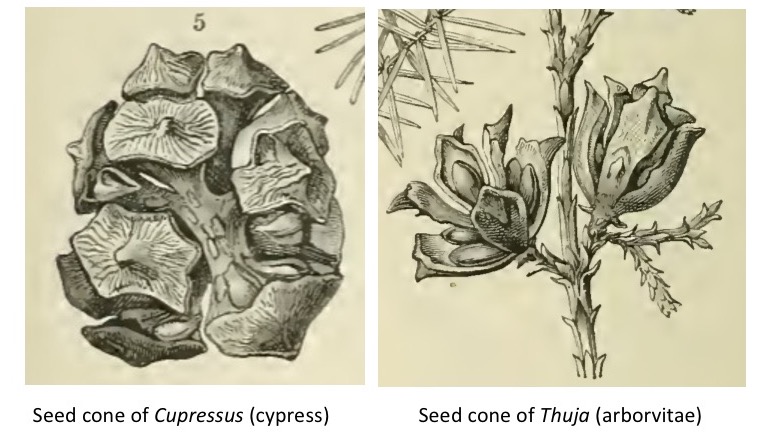
Cone scales may have prickles or not
Here is a little terminology you will probably not need. However, these terms help explain variation in the distal part of the cone scale.
These parts are shown below:
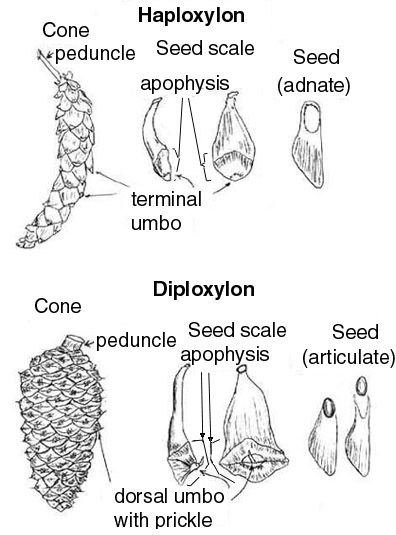
Check your understanding:
Seeds of some species have wings; seeds of others do not. Many times seeds will have dispersed or animals will have eaten the seeds by the time you find a cone on the ground. It is often possible, however, to see characteristics of seeds and their wings in the "shadows" and depressions or indentations they leave behind on the cone scale.
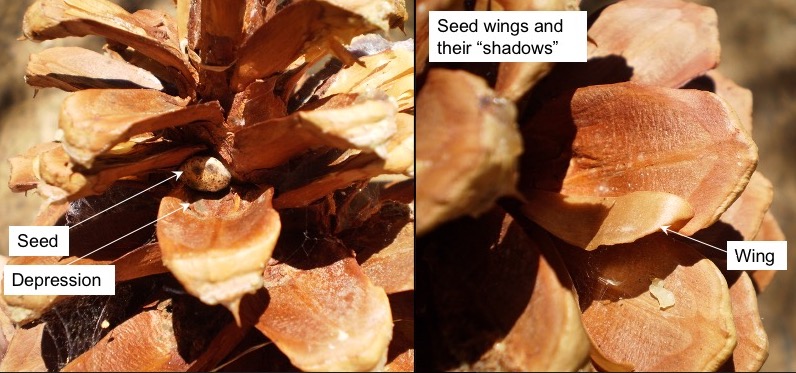
There are four families of Gymnosperms:
As a quick guide to differentiating these families:
The Ephedraceae has very long internodes, and its tiny leaves are often early-deciduous
At the other end of the spectrum: the Cupressaceae has leaves or leaf bases that completely cloak or cover the stem, so you cannot see any stem surface.
The Taxaceae and Pinaceae both have needle-like leaves that do NOT cloak the branches, but
Ephedra is the only genus in the family, Ephedraceae.
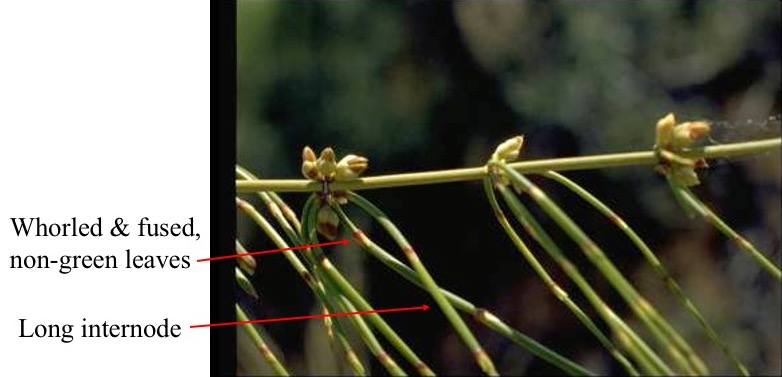
Species of Ephedra are dioecious
Check your understanding:
In the Cupressaceae
Genera that are included in the Cupressaceae include:
Also (formerly put into their own family, the Taxodiaceae):
The first four genera listed have opposite or whorled leaves.
The last two (Sequoia and Sequoiadendron) have alternate leaves:
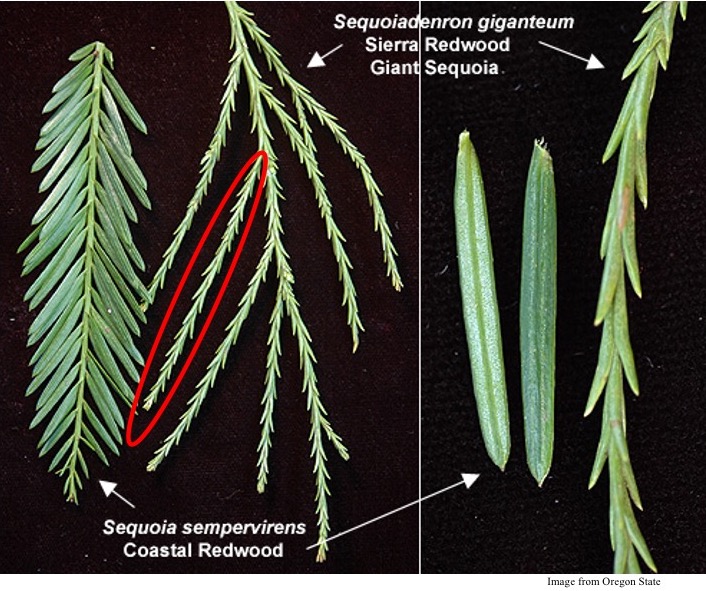
Check your understanding:
Below is an image of a branch of Thuja.
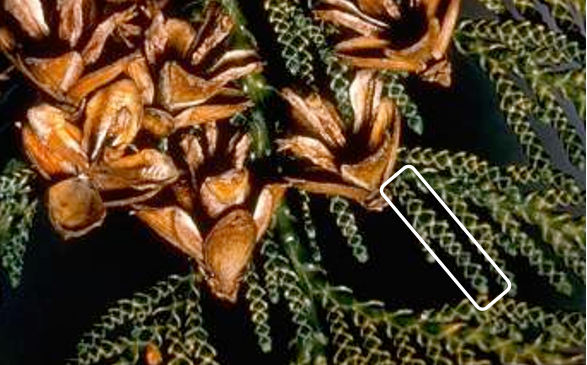
Here is another plant in the Cupressaceae. (Its leaves cloak the branch.)

Below is a magnification of a juniper branch (genus, Juniperus). You can see an oil gland on the back of each leaf.

Most members of the Cupressaceae have woody cones. However, some (notably, junipers) have fleshy cone scales. We tend to call these cones "juniper berries", even though they are not technically fruits. (Remember: in botanical terms, a berry is a fruit in which all layers of the ovary wall are fleshy at maturity - and junipers don't have ovaries.)
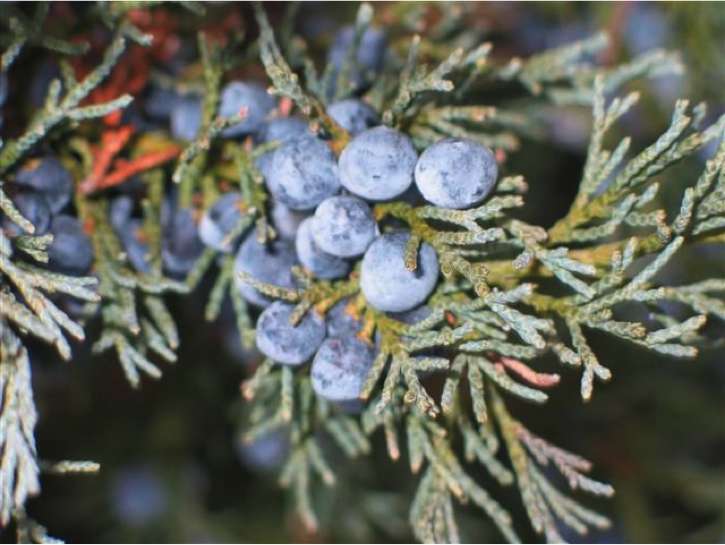
The family Pinaceae includes much more than pine trees. Pine trees are members of the genus, Pinus, only one of the genera in the Pinaceae.
Genera included in the Pinaceae include:
All members of the Pinaceae have alternate leaves, and the leaves do not cloak the branches. The trees are moneocious, bearing both pollen cones and seed cones on the same plant.
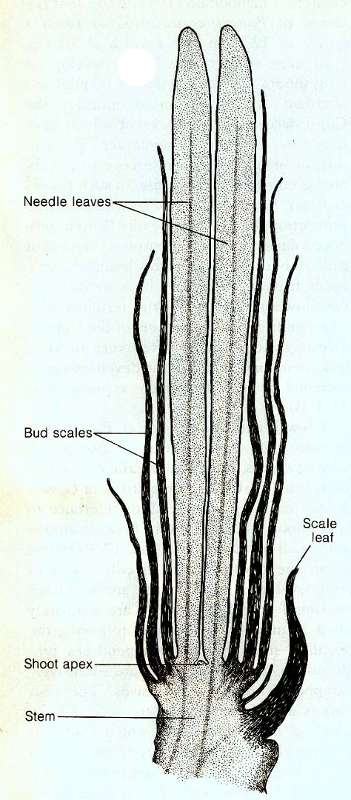 In the genus Pinus, most foliage leaves (or foliage needles) are borne on short, determinate branches, rather than attaching directly to the main stem. These short, determinate shoots or branches produce a series of scale leaves, then they produce 1 to 5 foliage needles, then the shoot apex stops growing. This short shoot and its bundle of foliage needles is called a fascicle.
In the genus Pinus, most foliage leaves (or foliage needles) are borne on short, determinate branches, rather than attaching directly to the main stem. These short, determinate shoots or branches produce a series of scale leaves, then they produce 1 to 5 foliage needles, then the shoot apex stops growing. This short shoot and its bundle of foliage needles is called a fascicle.
The scale leaves (labeled "bud scales" on the drawing shown here) are non-photosynthetic and typically wrap around the base of the foliage needles, forming a sheath. This structure is called...a sheath. Scale leaves that make up the sheath may remain wrapped around the foliage needles for a long time (until they wear away through age), or they may be deciduous, falling off early and leaving only the foliage needles attached to a bare peg of the stem of the short shoot.
The images below show scale leaves and fascicles with needles and sheaths on a young tree of Pinus jeffreyi (Jeffrey pine).
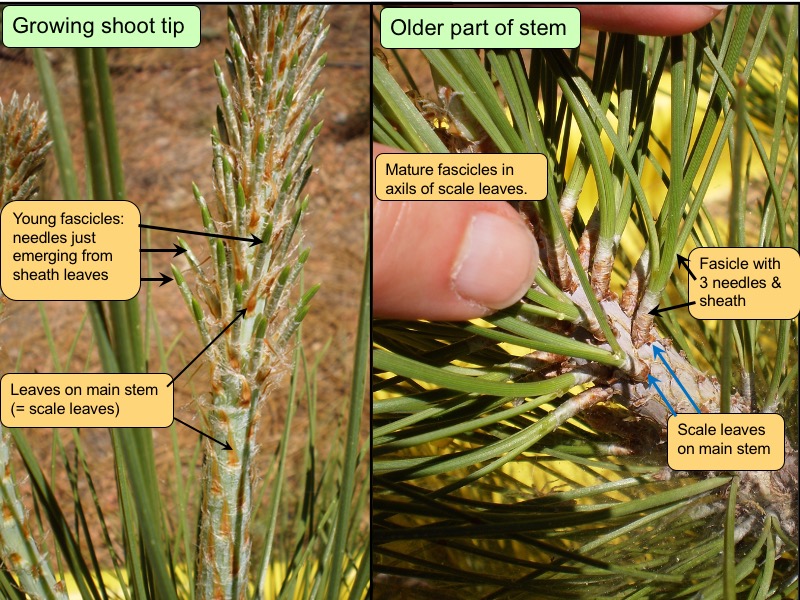
Check your understanding:
Below are photos of two pine species: Species "A" and Species "B".
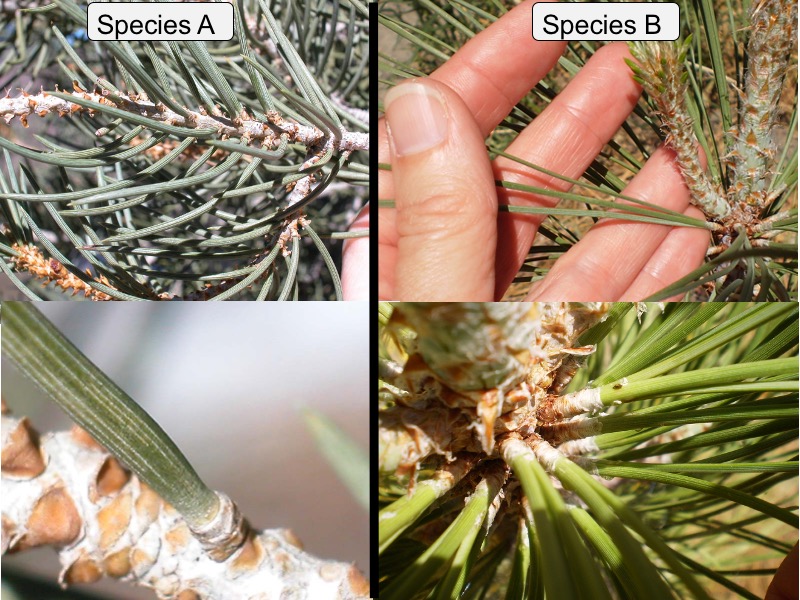
Fir trees (genus Abies) are also in the Pinaceae.
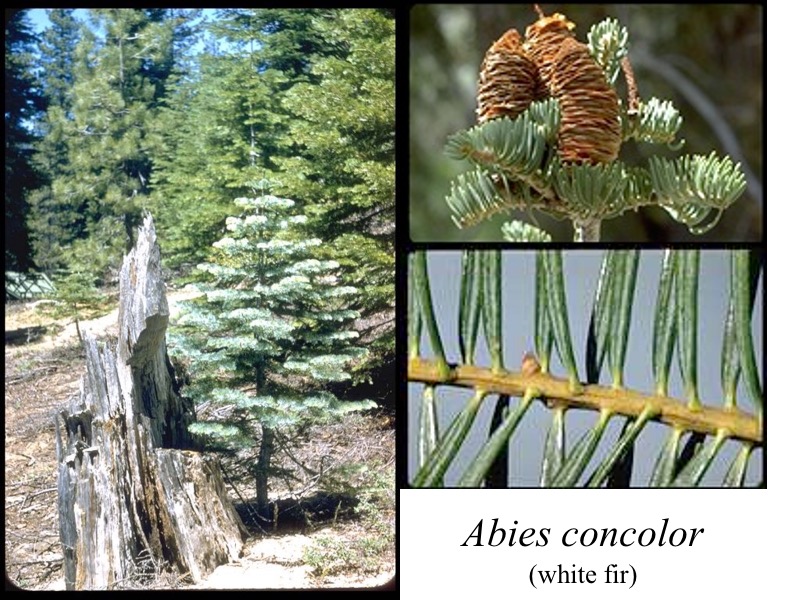
The genus Pseudotsuga is in the Pinaceae. This is the genus referred to a Douglas fir.
Its needles are not as blunt as fir needles, and its cones are pendent. The cones are recognizable by the three-lobed cone-scale bract that is exerted.
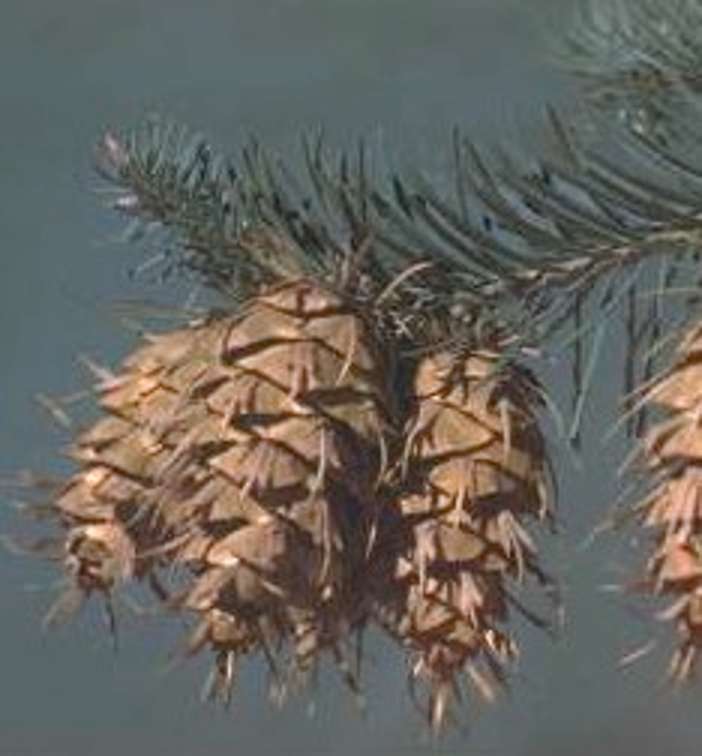
Spruce trees (genus Picea) and hemlock trees (genus Tsuga) are also in the Pinaceae. Species of both occur in California, but neither occur in Southern California. Therefore, we will not cover them this year.
Although members of the Taxaceae occur in California, none occur naturally in Southern California. The two species in this family that occur in Californa are shown below. This information is included for your information, but you will not be responsible for recognizing this family.
